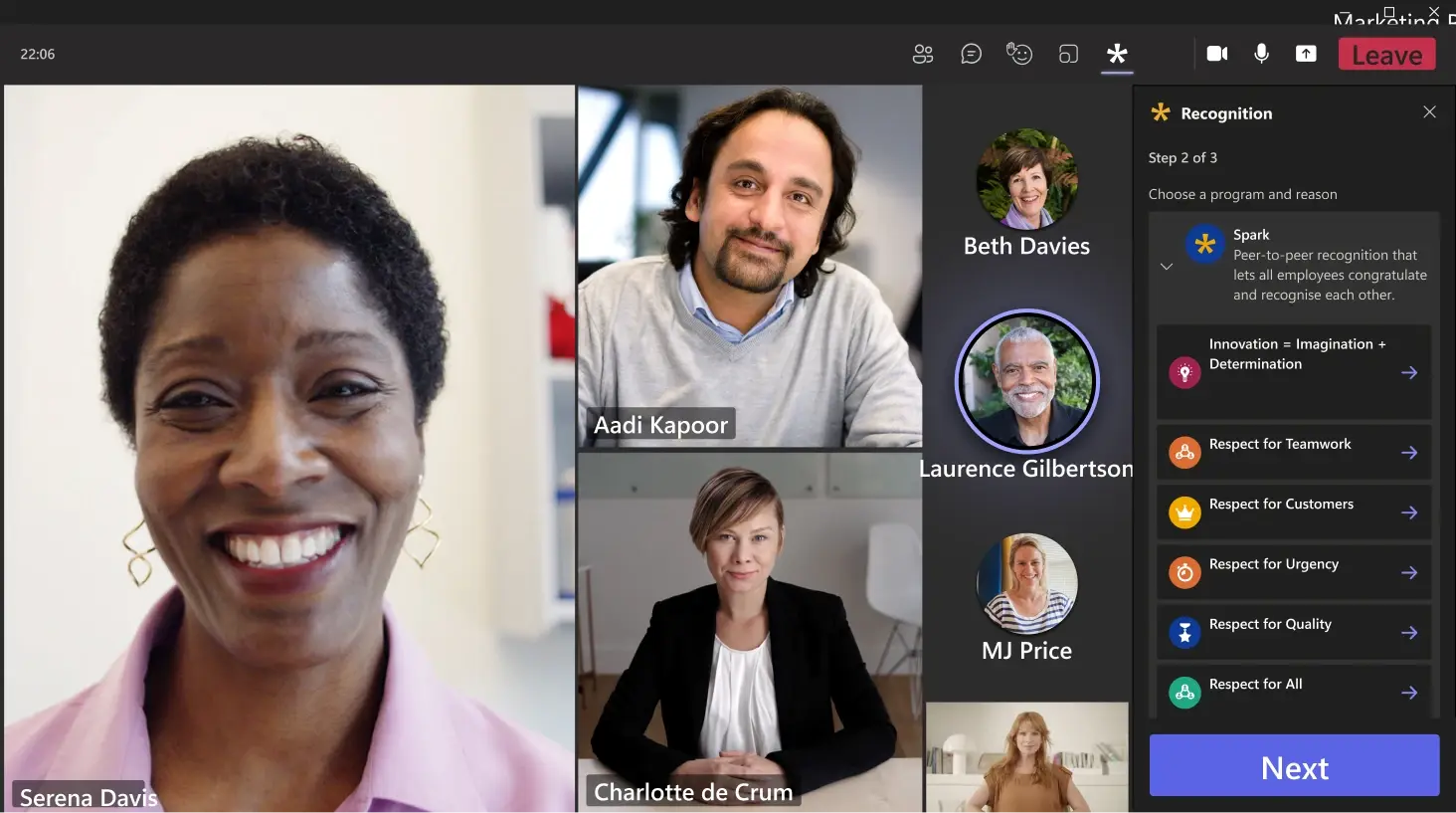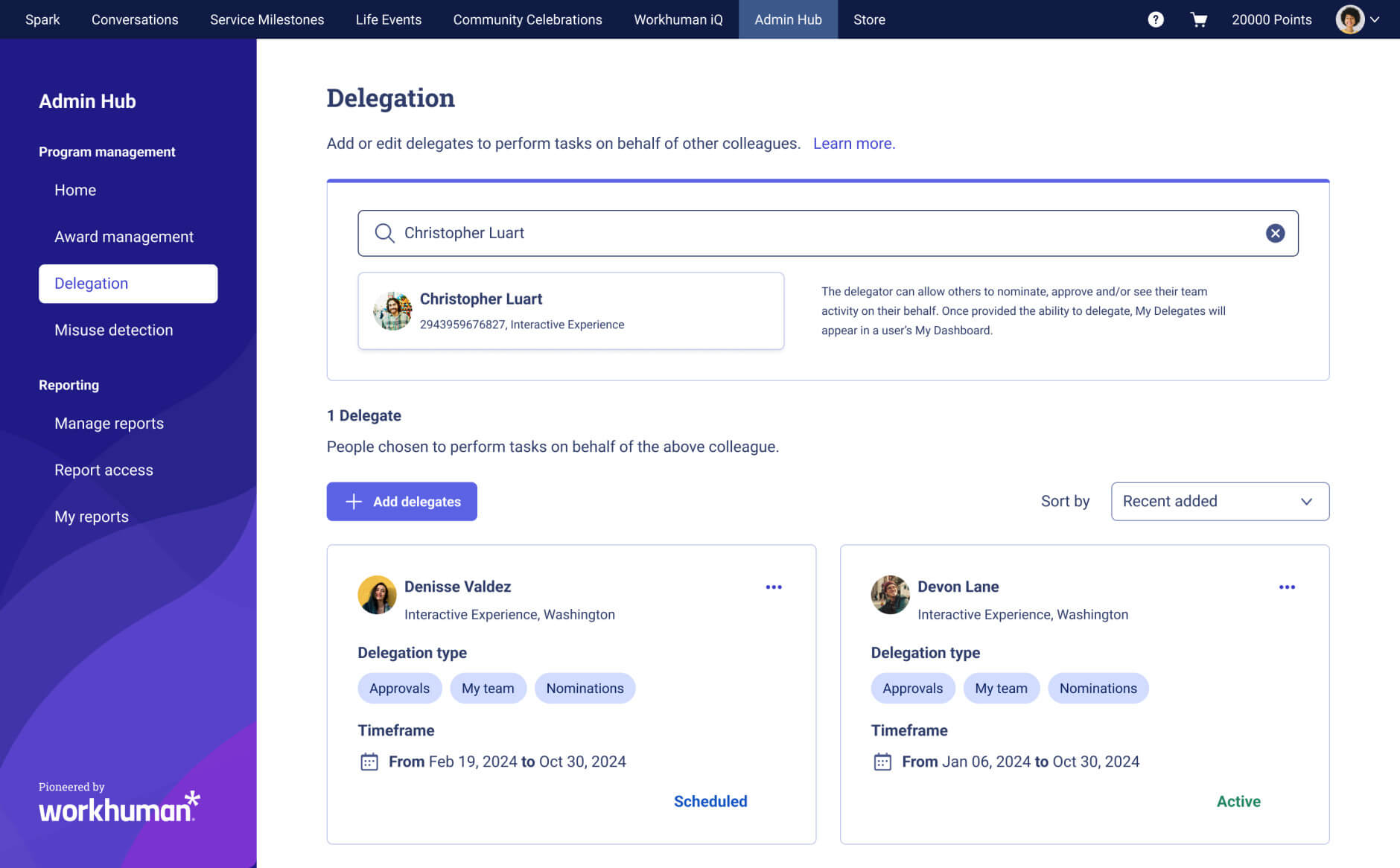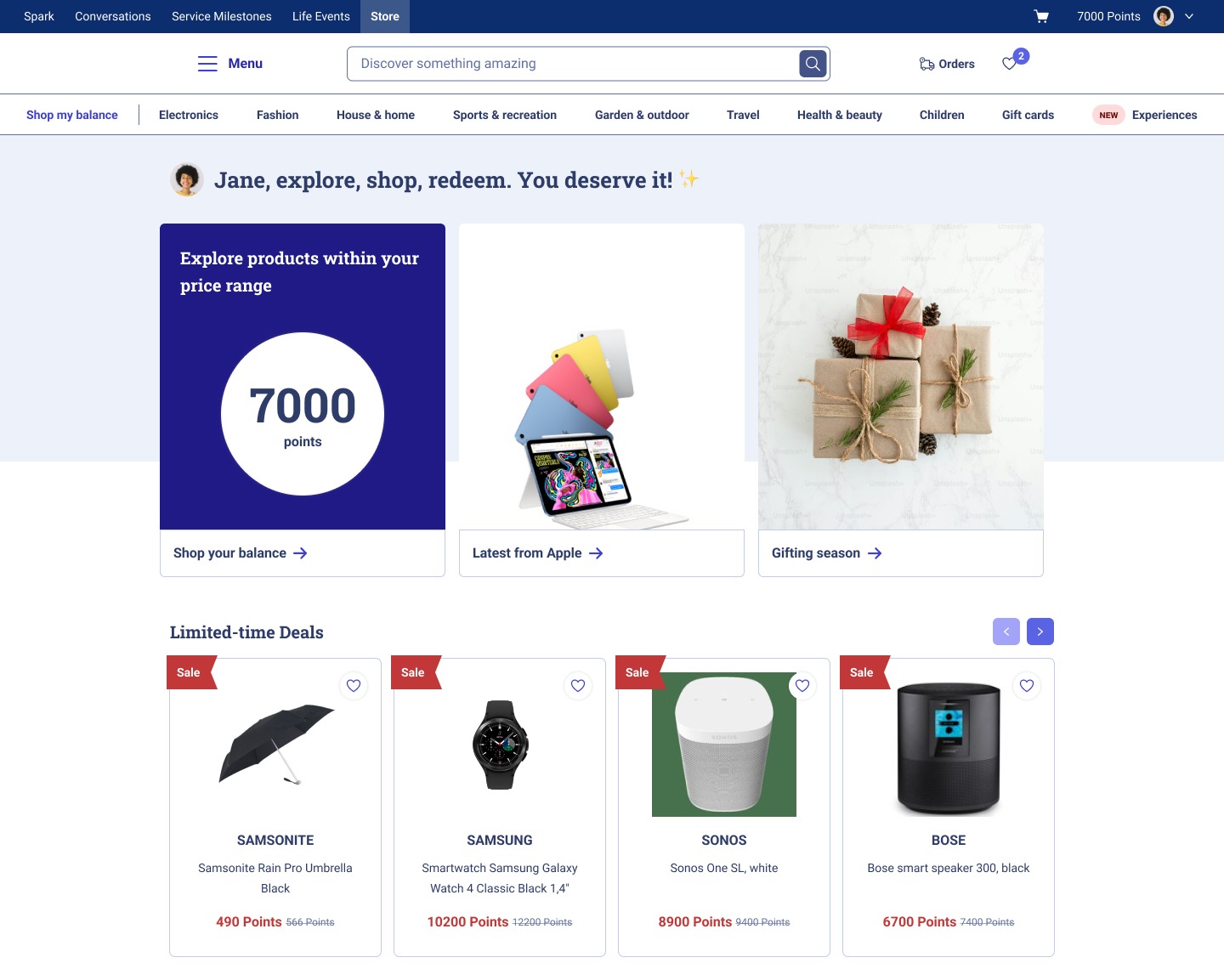Transforming Tomorrow: 4 Examples of Workhuman Innovation in the Workplace

Innovation happens nearly at the speed of light these days. It might seem too fast to catch up sometimes – but innovation also offers the opportunity for cultural acceleration. It bolsters new ideas and different ways of working to transform a workplace.
Innovation pushes us to our limits to find new and improved ways of doing things to work smarter. These new approaches can add up to measurable gains, not just in improved productivity, but also in the broader market. Innovation is the cornerstone of culture, and in order to stay competitive, you need to challenge the status quo and push boundaries to drive positive change in the world of work.
The importance of innovation for business growth
Making innovation a cultural pillar shows employees that you value creativity and evolution. Supporting creative problem-solving in the workplace enables your team to take risks and “shoot for the moon” rather than sticking to the status quo, which could potentially lead to stagnation and end with your brand getting left behind in favor of more innovative options. By encouraging workplace innovation, your business can thrive off creative thinking and new ideas, helping you to stay ahead of the competition.
As a leader in workplace culture innovation, Workhuman® is constantly searching for ways to make HR more efficient, more effective, and more human. In fact, during his keynote address at this year's Workhuman Live conferenceOpens in a new tab, Workhuman CEO Eric Mosley shared all new AI-powered innovations - industry-first features and capabilities that can help you work smarter and faster. Let's take a look at these four examples of innovation in the workplace:
Four examples of successful workplace innovations
Integrating AI and data analytics in decision-making
AI continues to lead workplace innovation, and it’s only the beginning. AI enables businesses to sift through vast datasets to uncover strategic insights faster, enabling them to make smart, data-driven decisions faster and with confidence.
As a result, leaders can anticipate market trends, understand employee behavior, and optimize processes with unprecedented precision. As organizations adopt these advanced technologies, they are better positioned to respond to dynamic business challenges with agility and informed confidence, setting new benchmarks for innovation and success.
Example #1: Workhuman iQ® & AI Assistant - leveraging AI for cultural intelligence
Workhuman iQ and the AI Assistant harness the power of AI to provide unprecedented insights into organizational culture and employee recognition trends. This AI-powered tool aggregates and analyzes data from the Workhuman platform to offer actionable insights and recommendations on enhancing workplace culture. Pulling from over 25 years of recognition program data, this tool is just what you need to monitor your cultural health and continue developing a strong team. Its features include:
- A virtual consultant that responds to specific queries through an AI chatbot, giving you full access to previously hidden workplace insights
- Data analysis at a glance for a holistic view on employee performance and overall organizational health
- iQ-fueled insights to identify skill gaps and highlight candidates for promotions or transfers
- Reports on demand for leaders and managers to absorb quickly and put into action
- Coaching for managers to improve team dynamics and recognition practices
Workhuman iQ exemplifies how you can leverage AI to foster a supportive and inclusive environment, making it an indispensable tool for any organization focused on building a strong, positive workplace culture. Through its comprehensive analysis and personalized recommendations, Workhuman iQ empowers leaders to make data-driven decisions that uplift and motivate their workforce, boosting both overall organizational health and performance.
Enhancing employee recognition through technology
Employee recognition is already an innovative idea, but to power a modern workplace, it needs continuous ideation. Enhancing employee recognition through technology enables organizations to empower their employees to engage in recognition in even more accessible yet still powerful ways. By leveraging technology and platforms like Workhuman, companies can embed recognition into their daily workflow, enabling instant and meaningful acknowledgment of employee achievements.
This seamless integration makes recognition a cornerstone of the organization and encourages employees to participate in the program as often as possible. Engaging with recognition and milestones in real-time builds appreciation into the everyday, leading to a more engaged, connected, and motivated work environment.
Example #2: Workhuman for Microsoft Teams - embedding recognition in daily workflow
Workhuman is now integrated with Microsoft Teams. This innovative solution puts recognition at employees’ fingertips, seamlessly incorporating recognition into their natural workflow. They’re already in Teams to share ideas, promote collaboration, have informal discussions, and run brainstorming sessions – why not enable them to share appreciation for these fresh ideas and innovative thinking amidst all the action?
Within the Teams environment, employees can easily send and receive recognition without needing to switch between applications, making the act of recognition more accessible and timely. This integration comes with a host of benefits, including:
- A Recognition Hub to house every recognition moment, enhancing visibility and encouraging a culture of recognition across the organization
- Recognition award notifications in the Teams “Activity” tab to offer a consolidated view of recipients’ accolades
- Seamless integration with your existing recognition program to ensure all data is aggregated for a holistic view
- Increased participation for more engagement and appreciation across teams
- Even more data (thanks to the increased participation) to analyze the overall health of the organization
With increased program participation, your team is bound to be even more engaged, connected, and productive.

Unifying program oversight: A leap towards streamlined organizational efficiency
Innovative companies need productive assets to improve operations, make informed decisions, measure success metrics, and measure against company goals. Unified HR systems help boost efficiency, foster transparent communication, and improve overall alignment with strategic objectives. Unifying program oversight helps give admins time back to focus on what really matters at work – supporting their people.
Employee programs can’t run smoothly without effective administrative management. Too often, admins’ work is spread across systems. They need a dedicated area to get all their work done to ensure the program is running seamlessly. Centralization enables a bird’s-eye view of program performance, enabling admins and decision-makers to identify areas of improvement, success stories, and potential new solutions to keep up employee engagement.
Example #3: Admin Hub - centralizing program management
Workhuman’s Admin Hub is the response to this key aspect of program management. Admin Hub is designed to empower program managers to oversee their recognition program in a centralized experience.
- Award management for real-time oversight of awards, enabling managers to approve, disapprove, or cancel awards as needed
- Delegation functionality to assign tasks and responsibilities to others, ensuring program continuity
- Misuse detection to proactively identify and alert managers to potential fraud, safeguarding program integrity
- Reporting functionality for in-depth insight into program metrics
With this streamlined approach, program managers have more time to focus on strategic initiatives to encourage employee participation and support leadership with continued innovation.

Revolutionizing e-commerce and reward systems
Employee recognition solutions hinge upon e-commerce and reward systems. After all, rewarding a job well done boosts employee satisfaction and encourages program engagement. But as technology continues to advance, modern e-commerce platforms must adapt as well. To support innovation and keep up with customer demand, e-commerce platforms are expanding redemption options, offering not just products but services and experiences as well. This evolution reflects a shift towards more personalized and engaging rewards, catering to diverse preferences and enhancing the perceived value of rewards.
Example #4: Modern E-commerce experience - expanding redemption choices
The Workhuman platform boasts a robust e-commerce experience that only continues to evolve. The latest update includes:
- 300 new stores for global gift card redemption
- A new Experiences platform with expanded offerings and the ability to book hotels, activities, excursions, and car rentals directly through the platform
- Improved user interface with faster loading times and improved accessibility, making for an overall smoother and more intuitive experience
These innovative solutions underscore Workhuman’s commitment to providing a user-centric platform that actively contributes to higher engagement levels and a more satisfied workforce.

How to foster innovation in your workplace
Fostering innovation in the workplace involves creating an environment that encourages creative thinking, experimentation, and the free exchange of ideas. Here are several strategies to encourage a culture of innovation:
Focus on jobs to be done
Encourage your team to focus on solving customer problems rather than just improving existing products. This "jobs to be done" theoryOpens in a new tab ensures that innovative efforts are geared toward what customers truly need.
Create space for innovation
Establish a dedicated space or unit separate from the core business where disruptive ideas can be tested and refined. Employees need to know that this is a safe space for trial and error where they can let their innovative ideas run wild and be as creative as possible.
Embrace experimentation and risk
Building off that, foster a culture that embraces risk-taking and learns from failures. Encouraging innovation with the understanding that not every idea will succeed empowers employees to take creative ideas into their own hands and see what works.
Encourage collaboration
If you want to drive innovation, you have to support collaboration. The best ideas aren’t born in a vacuum. Encourage employees to share ideas and build a teamwork-forward work environment.
Provide resources and support
Innovation efforts need resources. Make the necessary investments to support research, helpful tools and tech, and whatever else facilitates a leading-edge workplace.
Embrace diversity
Diverse backgrounds bring different perspectives and a whole lot of value to the workplace. Prioritize equitable hiring practices to cultivate a rich work culture.
Leadership and management
The most innovative companies have leaders who encourage outside-the-box thinking and promote a positive workplace environment where all employees feel empowered to contribute meaningfully to the organization’s mission.
Open communication
Open and transparent communication is crucial to foster a sense of trust. Employees can pick up on ingenuity and it can diminish their sense of safety at work. Be sure to keep things open and honest as you continue to innovate.
Employee recognition and rewards
A little appreciation goes a long way. Building recognition into your culture motivates employees to do their best and can encourage staff to bring their full selves to work every day.
Continuous learning
A culture of continuous learning and development is a great way to foster innovation and creative thinking.
Empowerment and trust
Show your employees that you trust them by empowering them to make decisions and take ownership of their work. This can motivate them to take calculated risks and try new things, leading to a greater payoff than if they played it safe.
Keep purpose front-and-center
Productivity and purpose are closely linked. Make your organizational mission and values clear and infuse them into all you do for a purpose-driven workforce.
By implementing these strategies, organizations can create a fertile ground for innovation, where employees are motivated to think creatively and contribute to the company's growth and success.
Challenges in workplace innovation
Innovation in the workplace is a driving force for growth, competitiveness, and efficiency. However, introducing and implementing innovative practices and ideas comes with its own set of challenges. It’s common to get pushback on workplace innovation – here’s how you can handle some of the difficulties that come with new ideas.
Resistance to change
It’s no secret that change is hard. It can feel even more difficult in the workplace where people have very set routines and strategies. Resistance to change often comes from fear of the unknown and concern over losing control or increasing workload. That’s why it’s crucial to accompany workplace innovation with open communication so staff members can feel informed and buy into the changes without too much hesitation or fear. This will also help foster a sense of psychological safety at they are putting their innovative ideas into action.
Finding time for innovation projects
Your employees might be full of innovative ideas, but finding time to take action on them can be difficult. Tasks pile up and experimental projects tend to be the first to be discarded in the face of more timely tasks. Not to mention that the smaller the company is, the harder it can be to uphold an innovative culture with such limited resources. This is why it’s crucial to make innovation a cornerstone of your work culture and overall organizational strategy. Allocating specific times for brainstorming sessions, encouraging cross-departmental collaboration, and setting aside resources for innovation projects can help encourage continued innovation.
Measuring the impact of innovation initiatives
How do you know the impact of your innovative ideas? Prioritizing workplace innovation is one thing, but knowing its influence on your business is another. The impact of innovation can be difficult to quantify, often improving processes, products, or services in ways that show up over time.
You can track activity metrics, such as how many new ideas have been generated, the number of employees working on innovation initiatives, and the number of new ideas being tested. Impact metrics are another option, like tracking revenue generated.
What may be more impactful than metrics, though, is a framework to determine how far a new idea goes. You should have a structure in place to track the progression of new ideas, checking in at certain milestones whether the project should proceed or not. This will help keep you accountable and make it easier to kill unproductive ideas.
Ensuring diversity of ideas
The innovation process thrives on a diversity of ideas. This means involving people with varied backgrounds in life and skillsets alike. A homogenous group is likely to come up with similar ideas, limiting the creativity potential. Diverse teams bring a range of perspectives, experiences, and skills to the table, which can elicit more creative and effective solutions. This starts with DEI-driven hiring practices and hinges upon a workplace that continuously pursues equity in all facets of the business.
Conclusion
Workplace innovation is the cornerstone of a leading company. It is the hallmark of an organization that isn’t afraid to take risks and try new ideas, and one that supports its employees in doing so. Innovation is how you keep moving forward both as a business and as part of the broader market, keeping your organization nimble and competitive.
At Workhuman, we work every day to create a more human, innovative workplace. Learn more about our latest product developments here to keep building the future of work.
About the author
Maeve Ginsberg
A wellness enthusiast and the mid-day walk’s #1 fan, Maeve champions work-life balance.
Having gone from a corporate job to self employment, Maeve has lived through countless working styles. This evolution forced confrontation of her own limiting beliefs, eventually breeding a completely individualized approach to work and productivity.
As a Senior Copywriter, Maeve often writes on workplace wellbeing and strives to advocate for all workers and leaders to find small yet significant ways to make their work lives healthier and more fulfilling.
Offline, Maeve enjoys testing new cuisines and hanging upside down off walls (also known as bouldering).